PERSONAL DETERMINANTS OF CONSUMER BEHAVIOR
Consumer behavior is a complex process influenced by a wide range of factors, including personal determinants that shape individuals’ choices, preferences, and purchasing decisions. These personal determinants reflect the unique characteristics and psychological aspects of consumers, influencing how they perceive, evaluate, and respond to various products, brands, and marketing stimuli. Understanding these personal determinants is crucial for businesses and marketers to effectively engage with their target audience and develop strategies that resonate with consumers on a personal level.
From personality traits and motivations to attitudes, beliefs, and lifestyle choices, these personal determinants provide valuable insights into the intricacies of consumer behavior and help unlock the keys to building strong relationships between brands and their customers. By recognizing and acknowledging these personal determinants, businesses can tailor their offerings, messaging, and experiences to meet the diverse needs and desires of consumers, ultimately driving satisfaction, loyalty, and long-term success.
The following are the personal determinants of consumer behavior:
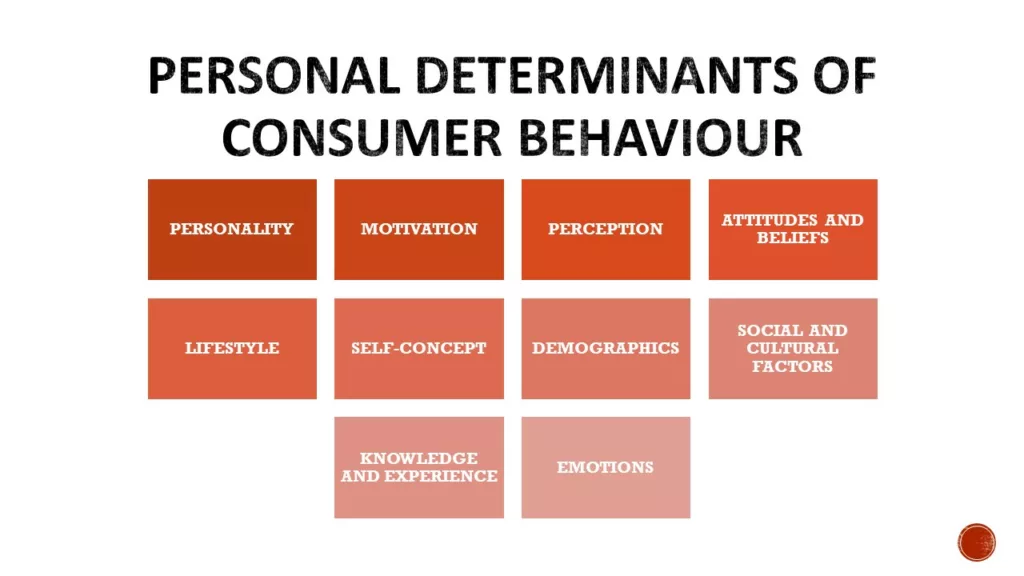
PERSONALITY
Personality is a significant personal determinant of consumer behavior. It refers to the unique set of enduring traits, characteristics, and patterns of thought, emotion, and behavior that differentiate one individual from another. Personality traits influence how individuals perceive, process, and respond to various stimuli, including products, brands, and marketing messages. Here’s how personality impacts consumer behavior:
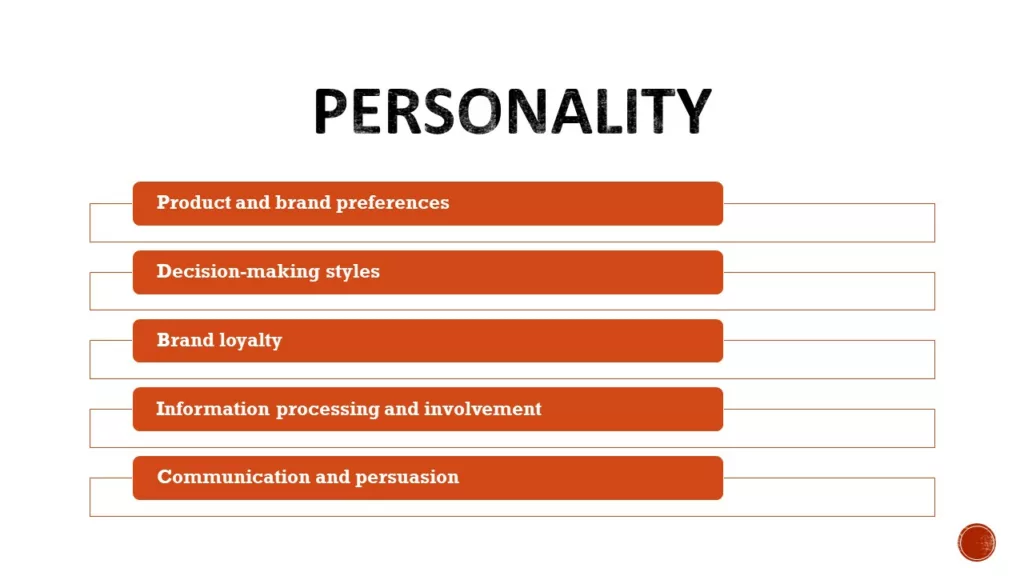
- Product and brand preferences: Different personality traits are associated with specific product and brand preferences. For example, individuals with an extraverted personality may be drawn to social and stimulating products, while introverts may prefer more solitary and introspective experiences. Personality traits like openness to experience, conscientiousness, and need for uniqueness can also influence preferences for innovative, reliable, or distinct brands.
- Decision-making styles: Personality traits affect consumers’ decision-making styles. Some individuals may be more rational and systematic in their decision-making, carefully evaluating options and considering objective factors. In contrast, others may be more impulsive or emotionally driven, making decisions based on intuition, feelings, or hedonic desires. Personality traits like impulsivity, risk-taking propensity, and self-confidence can impact decision-making styles.
- Brand loyalty: Personality traits play a role in brand loyalty. Consumers with certain personality characteristics, such as a need for stability or a high need for cognition, may exhibit stronger brand loyalty tendencies. They may develop deep emotional connections with brands that align with their values, self-concept, or desired image.
- Information processing and involvement: Personality traits can influence how individuals process information and their level of involvement in the decision-making process. For example, individuals with a high need for cognition tend to engage in extensive information search and consider detailed product information before making a purchase. In contrast, those with a low need for cognition may rely more on heuristics or emotional cues.
- Communication and persuasion: Personality traits impact how consumers respond to marketing communications and persuasive messages. Marketers often tailor their messages to resonate with specific personality traits. For instance, individuals high in extraversion may respond positively to lively and social-oriented advertisements, while those high in conscientiousness may be more persuaded by messages emphasizing reliability, quality, and attention to detail.
It’s important to note that personality is complex and multidimensional, and no single personality trait can fully predict consumer behavior. Consumers also possess a variety of personality traits that interact with situational factors, social influence, and other determinants. Understanding the relationship between personality and consumer behavior helps marketers segment their target audience, create personalized marketing strategies, and deliver tailored experiences that align with consumers’ unique personality profiles.
MOTIVATION
Motivation is a crucial personal determinant of consumer behavior that refers to the internal drive that leads individuals to pursue certain goals or satisfy specific needs. Motivation influences consumers’ attitudes, preferences, and decision-making processes. Here’s how motivation impacts consumer behavior:
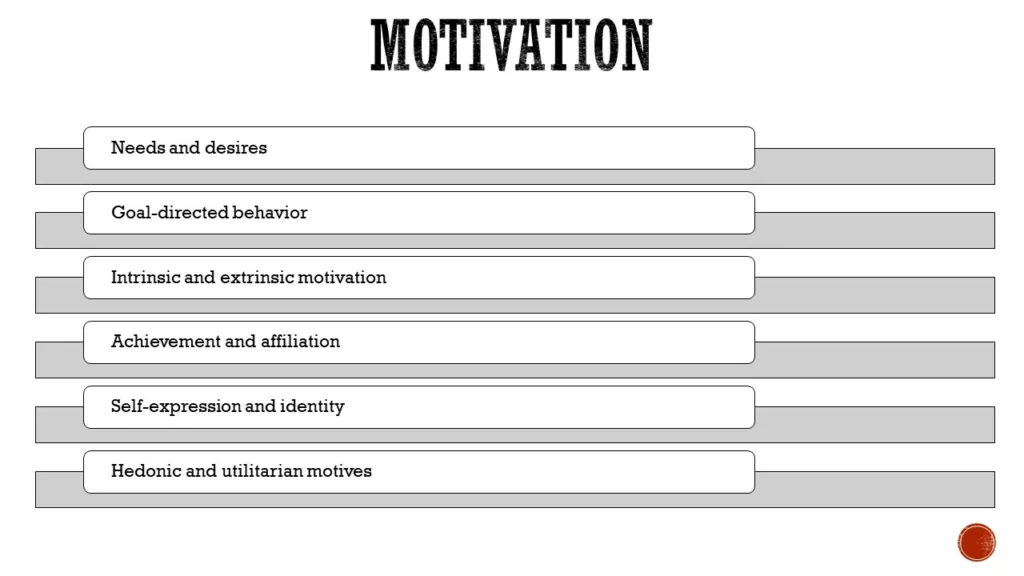
- Needs and desires: Motivation arises from unsatisfied needs or desires. Maslow’s hierarchy of needs theory suggests that individuals have a hierarchy of needs, starting from basic physiological needs (such as hunger and shelter) to higher-level needs (such as self-esteem and self-actualization). Consumers are motivated to fulfill these needs through their purchasing decisions. For example, someone experiencing the need for affiliation may be motivated to buy products that facilitate social connections.
- Goal-directed behavior: Motivation drives goal-directed behavior, where individuals set objectives and take action to achieve them. Consumers may set goals related to product acquisition, such as purchasing a particular item or saving money for a future purchase. Marketers can tap into consumers’ motivations by aligning their products or services with these goals, emphasizing how they can help consumers achieve their desired outcomes.
- Intrinsic and extrinsic motivation: Motivation can be categorized as intrinsic or extrinsic. Intrinsic motivation refers to the internal desire to engage in an activity or purchase a product because it provides inherent satisfaction or enjoyment. Extrinsic motivation, on the other hand, arises from external factors like rewards, social recognition, or status. Both types of motivation can influence consumer behavior. For example, consumers may buy a luxury item to fulfill their intrinsic desire for self-expression or purchase a product to gain social approval (extrinsic motivation).
- Achievement and affiliation: Consumer behavior is often driven by motives related to achievement and affiliation. Achievement motivation refers to the need for success, mastery, or accomplishment. Consumers with high achievement motivation may seek products or brands that are associated with accomplishment or enable them to display their competence. Affiliation motivation reflects the desire for social interaction, belongingness, or connection. Consumers motivated by affiliation may be attracted to products or brands that foster social connections or facilitate group identity.
- Self-expression and identity: Motivation can be driven by the need for self-expression and the formation of identity. Consumers often choose products or brands that align with their self-concept and desired image. By purchasing certain products, individuals express their values, preferences, and personal identity to themselves and others. Marketers leverage this motivation by positioning their products or brands as vehicles for self-expression and identity construction.
- Hedonic and utilitarian motives: Consumers are motivated by both hedonic and utilitarian motives. Hedonic motives involve seeking pleasure, sensory gratification, or emotional experiences through consumption. Consumers motivated by hedonic motives may be more inclined to purchase products that provide entertainment, enjoyment, or aesthetic experiences. Utilitarian motives, on the other hand, are driven by practicality and functionality. Consumers with utilitarian motives prioritize the functionality, reliability, and efficiency of products.
Understanding consumers’ motivations is essential for marketers to create relevant marketing messages, design appealing products, and deliver satisfying experiences. By aligning their offerings with consumers’ motivations, marketers can influence consumer behavior, enhance engagement, and build long-lasting relationships with their target audience.
PERCEPTION
Perception is a fundamental personal determinant of consumer behavior that refers to how individuals interpret and make sense of information from their environment. It influences how consumers perceive products, brands, and marketing messages, ultimately shaping their attitudes, preferences, and purchasing decisions. Here’s how perception impacts consumer behavior:
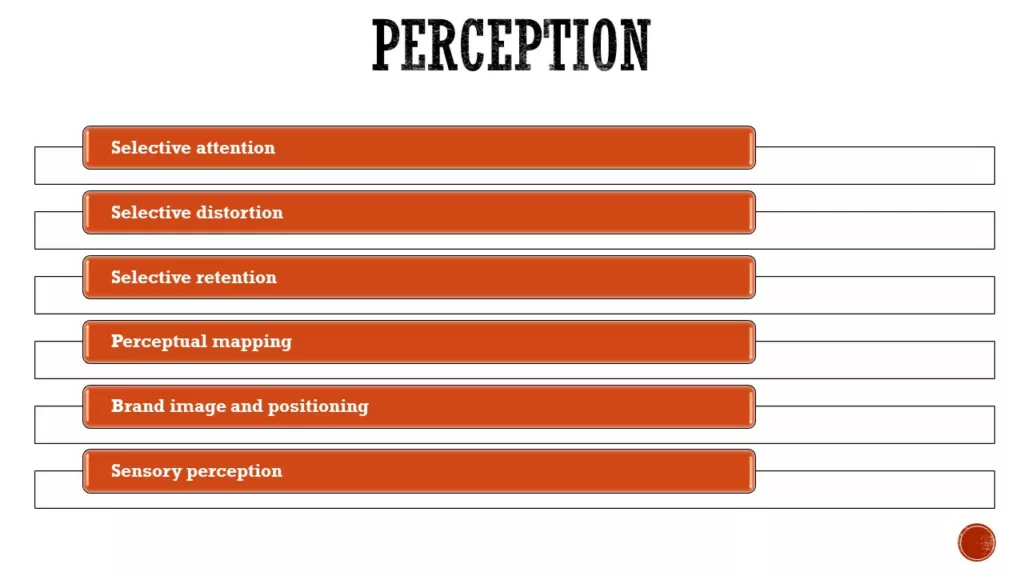
- Selective attention: Consumers are exposed to a vast amount of information, but they cannot pay equal attention to everything. Selective attention occurs when individuals focus their attention on specific stimuli while ignoring or filtering out others. Consumers are more likely to attend to information that is personally relevant, matches their needs or interests, or stands out from the surrounding environment. Marketers need to create attention-grabbing stimuli and effectively communicate the relevance of their offerings to capture consumers’ attention.
- Selective distortion: Selective distortion refers to the tendency of consumers to interpret information in a way that aligns with their existing beliefs, attitudes, or expectations. Consumers may distort or reinterpret information to fit their preconceived notions or avoid cognitive dissonance. Marketers should be aware of consumers’ existing perceptions and strategically address any potential gaps or misconceptions through clear and accurate communication.
- Selective retention: Consumers selectively retain and remember information that is consistent with their beliefs, interests, or needs. They are more likely to remember information that aligns with their existing attitudes or preferences. Marketers can enhance consumers’ selective retention by delivering memorable and emotionally resonant experiences, reinforcing positive associations with their products or brands.
- Perceptual mapping: Consumers create mental maps or representations of products or brands based on their perceptions of key attributes. Perceptual mapping involves consumers’ subjective evaluation and positioning of products or brands in relation to each other. Marketers can influence consumers’ perception by strategically positioning their products or brands based on desired attributes or unique selling points.
- Brand image and positioning: Perception plays a crucial role in shaping consumers’ brand image and positioning. Consumers form perceptions about brands based on various cues, including advertising, packaging, pricing, and word-of-mouth. Marketers strive to create positive brand associations and differentiate their offerings from competitors through carefully crafted brand positioning strategies. Consistent and coherent brand communication is essential to manage consumers’ perception and establish desired brand images.
- Sensory perception: Sensory cues, such as visual, auditory, olfactory, and tactile stimuli, significantly influence consumers’ perception of products or services. Consumers evaluate product quality, aesthetics, and usability based on sensory experiences. Marketers should pay attention to sensory cues and design their products, packaging, and in-store experiences to appeal to consumers’ senses and create positive sensory perceptions.
Understanding consumers’ perception is vital for marketers to effectively communicate their brand value, differentiate their offerings, and create positive associations in consumers’ minds. By managing consumers’ perception and delivering consistent, appealing, and relevant stimuli, marketers can influence consumer behavior, shape brand preferences, and foster long-term brand loyalty.
ATTITUDES AND BELIEFS
Attitudes and beliefs are important personal determinants of consumer behavior. Attitudes refer to an individual’s evaluative judgments or feelings towards an object, person, or idea, while beliefs are subjective perceptions or understandings that individuals hold about something. Attitudes and beliefs significantly influence consumers’ preferences, decision-making processes, and purchasing behavior. Here’s how attitudes and beliefs impact consumer behavior:
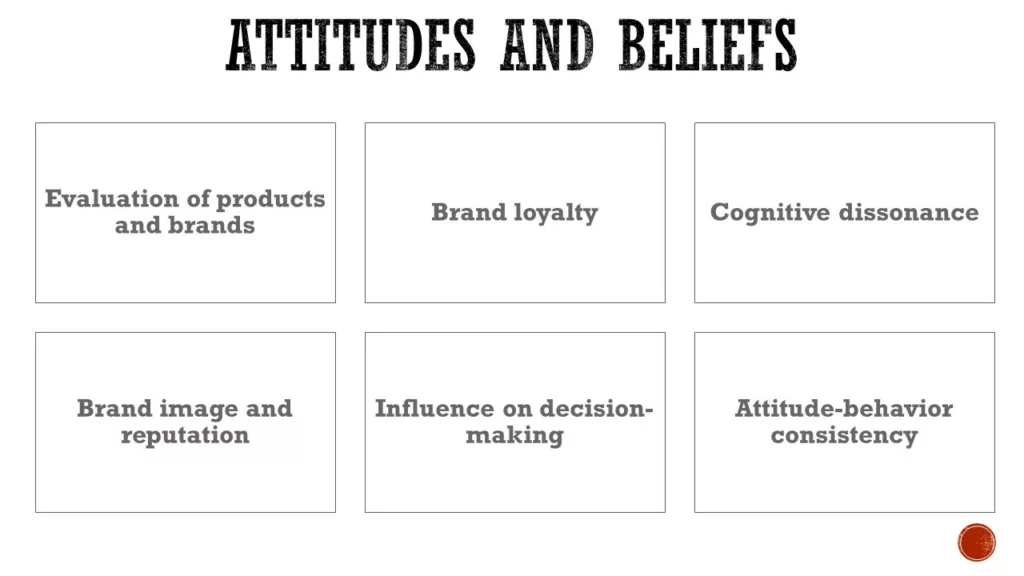
- Evaluation of products and brands: Attitudes play a critical role in how consumers evaluate and perceive products or brands. Positive attitudes towards a product or brand can lead to higher levels of preference and purchase intention, while negative attitudes can deter consumers from considering or purchasing certain products. Marketers aim to shape positive attitudes through effective brand positioning, advertising, and experiences that align with consumers’ values, needs, and desires.
- Brand loyalty: Attitudes and beliefs contribute to brand loyalty. Consumers with positive attitudes towards a particular brand are more likely to exhibit brand loyalty, repeatedly purchasing and recommending that brand to others. Positive attitudes may be formed through past positive experiences, favorable perceptions of the brand’s attributes, or alignment with personal values and self-identity.
- Cognitive dissonance: Attitudes and beliefs also play a role in consumers’ experience of cognitive dissonance, which is the discomfort or tension that arises when individuals hold conflicting beliefs or attitudes. Consumers strive to reduce cognitive dissonance by seeking information or engaging in behaviors that align with their beliefs or attitudes. Marketers can address cognitive dissonance by providing reassuring information, emphasizing the positive attributes or benefits of their products, or offering after-sales support.
- Brand image and reputation: Attitudes and beliefs shape consumers’ perceptions of a brand’s image and reputation. Consumers develop attitudes towards brands based on their beliefs about the brand’s quality, reliability, value, social responsibility, and other relevant attributes. Positive brand image and reputation can enhance consumers’ trust, credibility, and willingness to engage with the brand.
- Influence on decision-making: Attitudes and beliefs influence consumers’ decision-making processes. Consumers with strong positive attitudes towards a product or brand are more likely to make favorable purchase decisions, while those with negative attitudes may avoid or reject certain options. Beliefs about product attributes, performance, and benefits also shape consumers’ decision-making criteria and preferences.
- Attitude-behavior consistency: Attitudes and beliefs are not always perfectly aligned with behavior, but they can influence consumers’ behavior to a significant extent. Consumers often act in accordance with their attitudes and beliefs, especially when they have a high level of involvement or commitment to the product or brand. Marketers strive to align consumers’ attitudes and beliefs with desired behaviors through persuasive communication, consistent brand experiences, and reinforcement of positive associations.
Understanding consumers’ attitudes and beliefs is essential for marketers to effectively position their products or brands, shape consumer preferences, and influence purchase decisions. By identifying and addressing consumer attitudes and beliefs through targeted messaging, tailored experiences, and transparent communication, marketers can build stronger connections with consumers and foster long-term brand loyalty.
LIFESTYLE
Lifestyle is a significant personal determinant of consumer behavior that refers to the way individuals live and express their values, interests, activities, and aspirations. Lifestyle encompasses various aspects of consumers’ daily lives, such as their hobbies, social interactions, leisure activities, and consumption patterns. Here’s how lifestyle impacts consumer behavior:
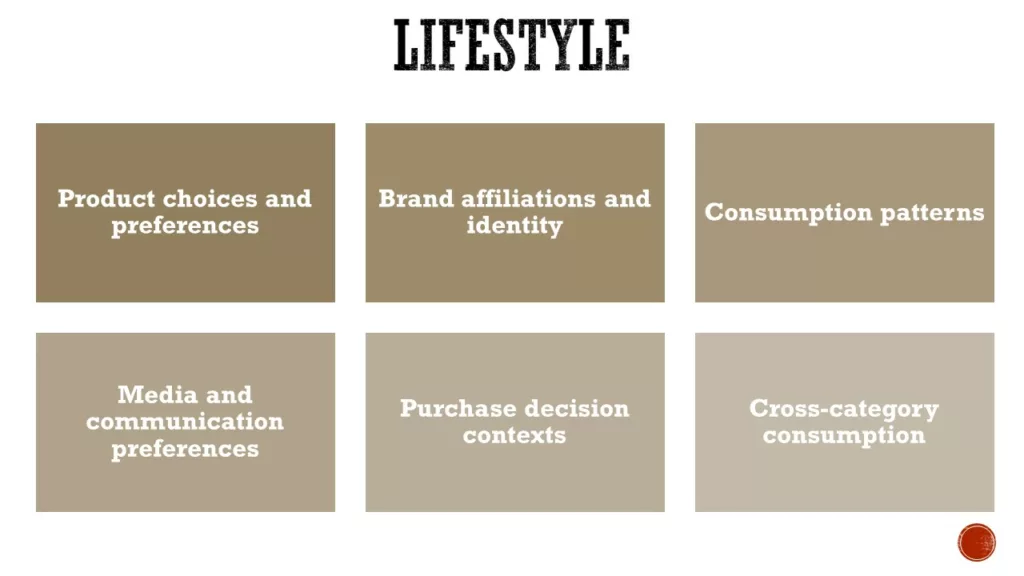
- Product choices and preferences: Lifestyle influences consumers’ product choices and preferences. Different lifestyles are associated with distinct sets of needs, interests, and values, which shape consumers’ preferences for specific products or brands. For example, an active and health-conscious lifestyle may lead individuals to choose fitness-related products or organic food options. Marketers often segment their target audience based on lifestyle characteristics to create targeted marketing strategies.
- Brand affiliations and identity: Lifestyle plays a significant role in shaping consumers’ brand affiliations and self-identity. Consumers often choose products or brands that align with their desired lifestyle or the image they wish to project. For instance, individuals with an eco-friendly lifestyle may prefer brands that promote sustainability and environmental responsibility. Marketers can tap into consumers’ lifestyles by positioning their products or brands as a means of expressing or enhancing a particular lifestyle.
- Consumption patterns: Lifestyles influence consumers’ consumption patterns, including their frequency and intensity of purchasing, product usage, and brand loyalty. Some lifestyles may involve frequent upgrading or trying out new products, while others may prioritize longevity and durability. Marketers need to understand consumers’ consumption patterns within specific lifestyles to tailor their marketing strategies accordingly.
- Media and communication preferences: Lifestyles influence consumers’ media consumption and communication preferences. Individuals with specific lifestyles may be more inclined towards certain media channels, social media platforms, or communication styles. Marketers should consider consumers’ lifestyle preferences to effectively reach and engage with their target audience through the most relevant and preferred communication channels.
- Purchase decision contexts: Lifestyles impact the contexts in which purchase decisions are made. Consumers’ lifestyles determine their exposure to different environments, social groups, and influencers, which can significantly influence their decision-making processes. For example, a lifestyle focused on adventure and exploration may lead consumers to seek recommendations from outdoor enthusiasts or engage with adventure-themed online communities before making purchase decisions.
- Cross-category consumption: Lifestyle often extends beyond a specific product or brand category. Consumers with a particular lifestyle may exhibit consistent consumption patterns across different categories. Marketers can leverage this by offering complementary products or creating cross-category promotions that cater to consumers’ lifestyles.
Understanding consumers’ lifestyles helps marketers identify relevant target segments, develop personalized marketing strategies, and create products or experiences that align with consumers’ desired ways of living. By recognizing and catering to consumers’ lifestyles, marketers can establish stronger connections with their target audience, foster brand loyalty, and enhance overall consumer satisfaction.
SELF-CONCEPT
Self-concept, also known as self-identity or self-image, is a personal determinant of consumer behavior that refers to how individuals perceive and define themselves. It encompasses the beliefs, values, attitudes, and perceptions that individuals have about their own qualities, characteristics, roles, and relationships. Self-concept influences consumers’ behaviors, choices, and preferences in various ways. Here’s how self-concept impacts consumer behavior:
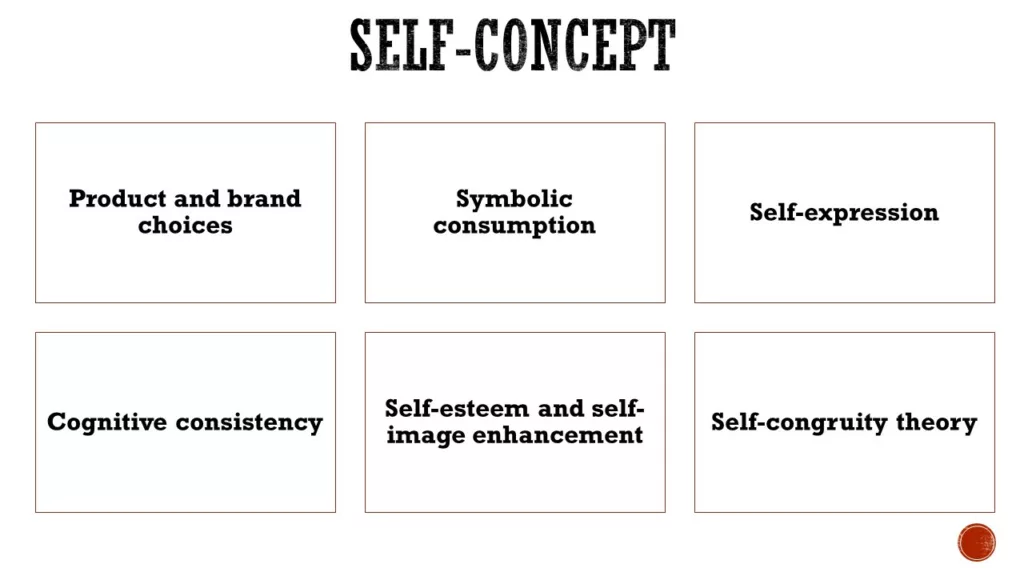
- Product and brand choices: Consumers’ self-concept influences their product and brand choices. Individuals often seek products or brands that align with their self-perception and help express their desired identity. For example, someone who identifies as environmentally conscious may choose eco-friendly products. Marketers leverage self-concept by positioning their products or brands to resonate with specific self-identities and values.
- Symbolic consumption: Self-concept drives consumers’ engagement in symbolic consumption. Symbolic products or brands hold meaning and communicate a desired image or social identity. Consumers use these products as symbols to express and communicate their self-concept to others. For example, luxury brands may be seen as a status symbol for those with a self-concept centered around prestige and social status.
- Self-expression: Self-concept influences consumers’ desire for self-expression through their consumption choices. Consumers often use products or brands as a means of expressing their unique personalities, values, and interests. They select items that help them communicate who they are or aspire to be. Marketers can tap into consumers’ self-expression motivations by offering customizable or personalized products that allow consumers to reflect their unique self-concept.
- Cognitive consistency: Self-concept drives consumers’ desire for cognitive consistency. Individuals seek harmony between their self-perception and their purchase decisions to maintain a positive self-image. Consumers are more likely to choose products or brands that are congruent with their self-concept and avoid those that contradict it. Marketers can enhance consumers’ cognitive consistency by aligning their brand image, values, and messaging with their target audience’s self-concept.
- Self-esteem and self-image enhancement: Self-concept is closely tied to individuals’ self-esteem and self-image. Consumers seek products or experiences that enhance their self-esteem or reinforce positive self-perceptions. For example, a fitness enthusiast may purchase fitness equipment to reinforce their self-concept as a healthy and active individual. Marketers can highlight how their products or services contribute to self-esteem enhancement to attract consumers with specific self-concepts.
- Self-congruity theory: Self-congruity theory suggests that consumers are more likely to choose products or brands that are congruent with their self-concept. Self-congruity refers to the match between consumers’ self-concept and the attributes or associations of a product or brand. Marketers can strategically emphasize and communicate how their offerings align with consumers’ self-concept to increase appeal and preference.
Understanding consumers’ self-concept helps marketers tailor their marketing strategies, position their products or brands effectively, and create personalized experiences that resonate with consumers’ desired self-identities. By recognizing and aligning with consumers’ self-concept, marketers can establish stronger emotional connections, enhance brand loyalty, and create a sense of authenticity and relevance in their target audience’s lives.
DEMOGRAPHICS
Demographics refer to the quantifiable characteristics of a population, such as age, gender, income, education, occupation, marital status, and geographic location. Demographics play a significant role as personal determinants of consumer behavior. They provide valuable insights into the characteristics and behaviors of different consumer groups. Here’s how demographics impact consumer behavior:

- Segmenting and targeting: Demographics are commonly used to segment and target specific consumer groups. Marketers analyze demographic data to identify distinct market segments with similar characteristics and needs. By understanding the demographic profiles of their target audience, marketers can tailor their marketing strategies and messages to effectively reach and engage with specific consumer segments.
- Consumer needs and preferences: Demographics provide insights into consumers’ needs, preferences, and consumption patterns. Different demographic groups have unique requirements and priorities. For example, the preferences and buying behaviors of millennials may differ from those of baby boomers. By understanding the demographic characteristics of their target audience, marketers can customize their products, services, and marketing efforts to better meet consumers’ specific needs and preferences.
- Media consumption habits: Demographics influence consumers’ media consumption habits. Different demographic groups have varying preferences for media channels, platforms, and content formats. For example, younger consumers may be more active on social media platforms, while older consumers may prefer traditional media channels like television or newspapers. Marketers can leverage demographic data to strategically allocate their advertising budgets and choose the most effective media channels to reach their target audience.
- Pricing and affordability: Demographics, particularly income and socioeconomic status, play a crucial role in determining consumers’ purchasing power and affordability. Consumers with higher incomes may have different price sensitivities and purchasing behaviors compared to those with lower incomes. Marketers need to consider the demographic factors that impact consumers’ financial capabilities when setting prices, offering discounts, or designing pricing strategies.
- Cultural influences: Demographics, including geographic location and ethnic background, influence consumers’ cultural norms, values, and preferences. Cultural factors shape consumers’ attitudes, beliefs, and behaviors. Marketers should be aware of cultural differences associated with different demographic groups to develop culturally sensitive marketing campaigns and avoid cultural misunderstandings or insensitivities.
- Consumer life stages: Demographics, such as age and marital status, often correspond to different life stages. Life stages influence consumers’ needs, priorities, and purchasing behaviors. For example, individuals in their early twenties may have different needs and preferences compared to those in their thirties with growing families. Marketers can consider the life stage characteristics associated with different demographics to tailor their products, services, and marketing messages accordingly.
By understanding the demographic characteristics of their target audience, marketers can gain insights into consumer behavior, effectively segment their market, and develop targeted marketing strategies. However, it’s important to note that demographics provide a broad overview and should be combined with other psychographic and behavioral factors for a more comprehensive understanding of consumer behavior.
SOCIAL AND CULTURAL FACTORS
Social and cultural factors are significant personal determinants of consumer behavior. These factors encompass the social and cultural influences that shape individuals’ attitudes, beliefs, values, norms, and behaviors. They play a crucial role in influencing consumer decision-making processes and consumption patterns. Here’s how social and cultural factors impact consumer behavior:
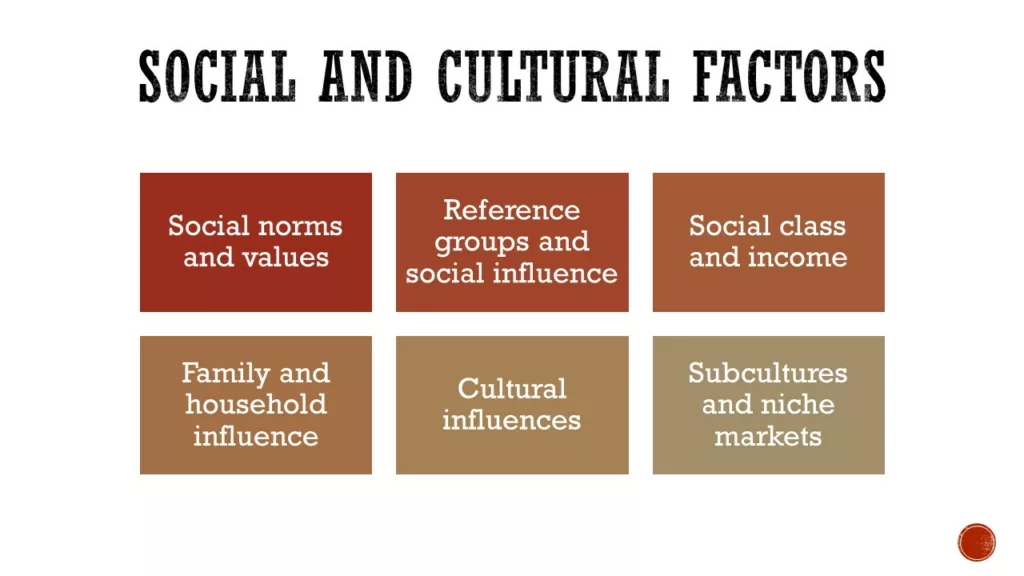
- Social norms and values: Social norms refer to the unwritten rules and expectations within a society that govern individuals’ behavior. Cultural values are shared beliefs and principles that shape the preferences and priorities of a particular culture or society. Consumers often conform to social norms and uphold cultural values in their purchasing decisions. Marketers need to be aware of the prevailing social norms and cultural values to align their products, marketing messages, and brand positioning with consumers’ expectations and values.
- Reference groups and social influence: Reference groups are individuals or groups that consumers look to for guidance, social comparison, and validation. These groups can include family, friends, peers, or opinion leaders. Consumers are influenced by the opinions, recommendations, and behaviors of their reference groups. Marketers can leverage social influence by targeting influential individuals within reference groups or utilizing social proof strategies to encourage positive word-of-mouth and social endorsement.
- Social class and income: Social class and income significantly impact consumers’ purchasing behavior. Social class reflects individuals’ economic position, occupation, education, and lifestyle. It influences consumers’ preferences for certain brands, products, and consumption patterns. Income levels also determine consumers’ purchasing power and affordability. Marketers need to consider social class and income disparities to develop pricing strategies, product positioning, and marketing communication that cater to different segments of the market.
- Family and household influence: The family and household environment have a strong influence on consumer behavior. Family members often share values, interests, and consumption habits, influencing each other’s purchasing decisions. Marketers can target family-oriented marketing campaigns or develop products that cater to specific family needs and dynamics.
- Cultural influences: Culture plays a significant role in shaping consumer behavior. Culture encompasses the shared beliefs, values, customs, traditions, and symbols within a society or group. Consumers’ attitudes, preferences, and consumption patterns are influenced by their cultural background. Marketers should consider cultural factors, such as language, symbolism, rituals, and cultural references, to create culturally relevant marketing strategies that resonate with consumers’ cultural identities.
- Subcultures and niche markets: Subcultures are smaller groups within a larger culture that share distinctive values, beliefs, and behaviors. Subcultures can be based on factors such as age, gender, religion, ethnicity, or interests. Consumers’ affiliation with subcultures influences their consumption choices and brand preferences. Marketers can target specific subcultures or niche markets by understanding their unique characteristics, preferences, and consumption patterns.
Understanding social and cultural factors helps marketers develop culturally sensitive marketing strategies, create relevant and resonant brand messages, and align their products with consumers’ values and expectations. By recognizing the social and cultural influences on consumer behavior, marketers can establish stronger connections with their target audience, build brand loyalty, and foster positive brand perceptions within specific cultural contexts.
KNOWLEDGE AND EXPERIENCE
Knowledge and experience are personal determinants of consumer behavior that influence individuals’ decision-making processes and consumption patterns. Here’s how knowledge and experience impact consumer behavior:
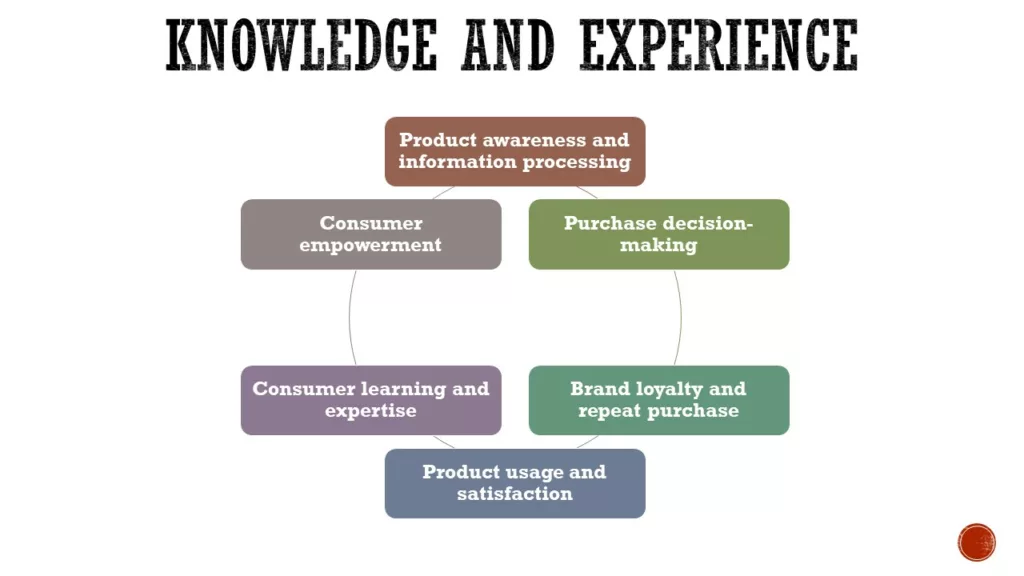
- Product awareness and information processing: Knowledge about products, brands, and their attributes is crucial in consumer decision-making. Consumers with more extensive product knowledge are better equipped to evaluate alternatives, make informed choices, and assess the value and benefits offered by different options. Marketers can provide relevant product information and educational content to enhance consumers’ knowledge and facilitate their decision-making process.
- Purchase decision-making: Consumer knowledge and experience influence the complexity of the decision-making process. Consumers with high knowledge and experience may engage in more extensive information search, evaluation, and consideration before making a purchase decision. On the other hand, consumers with limited knowledge or less involvement in a specific product category may rely more on external cues, such as brand reputation or recommendations from others. Marketers can adapt their marketing strategies based on consumers’ level of knowledge and decision-making involvement.
- Brand loyalty and repeat purchase: Knowledge and experience play a role in brand loyalty and repeat purchase behavior. Consumers who have positive experiences with a particular brand or product are more likely to develop brand loyalty and become repeat customers. Repeat purchase behavior is often driven by consumers’ familiarity with the brand, confidence in its quality, and positive past experiences. Marketers can focus on delivering exceptional customer experiences to build brand loyalty and encourage repeat purchases.
- Product usage and satisfaction: Knowledge and experience influence consumers’ product usage and satisfaction levels. Consumers with higher product knowledge are more likely to understand how to use a product effectively, resulting in greater satisfaction. Similarly, consumers with prior experience or expertise in a specific product category may have more nuanced expectations and evaluate product performance based on their knowledge and past experiences. Marketers should provide clear instructions, user guides, and support to enhance consumers’ product usage experience and overall satisfaction.
- Consumer learning and expertise: Knowledge and experience contribute to consumer learning and expertise in specific product categories. Over time, consumers acquire knowledge and develop expertise through repeated exposure, usage, and learning. This expertise can shape their preferences, evaluation criteria, and decision-making processes. Marketers can leverage consumers’ expertise by providing advanced or specialized products that cater to their specific needs and interests.
- Consumer empowerment: Knowledge and experience empower consumers to make more informed choices and assert their preferences. With easy access to information and online reviews, consumers can educate themselves about products, compare alternatives, and voice their opinions. Marketers need to recognize the empowered consumer and engage in transparent, honest communication to build trust and credibility.
Understanding consumers’ knowledge and experience levels helps marketers tailor their communication strategies, provide relevant information, and offer personalized experiences. By acknowledging consumers’ existing knowledge and leveraging their experiences, marketers can foster trust, enhance customer satisfaction, and establish long-term relationships with their target audience.
EMOTIONS
Emotions play a significant role as personal determinants of consumer behavior. Emotions refer to the subjective experiences and reactions individuals have towards stimuli, events, or situations. Emotions can strongly influence consumers’ attitudes, perceptions, decision-making processes, and ultimately their purchasing behavior. Here’s how emotions impact consumer behavior:
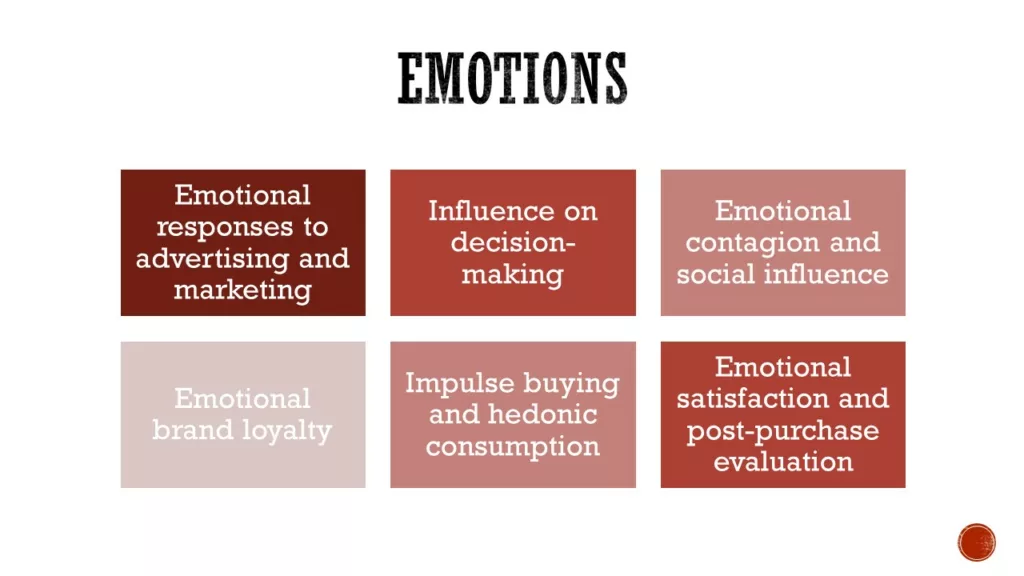
- Emotional responses to advertising and marketing: Emotional appeals in advertising and marketing messages can elicit emotional responses from consumers. Emotions such as joy, excitement, fear, or nostalgia can capture consumers’ attention, create memorable experiences, and influence their attitudes towards brands and products. Marketers often utilize emotional branding strategies to establish an emotional connection with consumers and evoke positive emotions associated with their offerings.
- Influence on decision-making: Emotions can heavily influence consumers’ decision-making processes. Emotions can either facilitate or hinder decision-making, depending on the specific emotion experienced. Positive emotions, such as happiness or excitement, can enhance consumers’ willingness to take risks, try new products, and make impulsive purchases. Negative emotions, such as fear or anger, can lead to avoidance behaviors or a desire for reassurance and safety. Marketers can leverage emotional appeals to influence consumers’ decision-making by creating positive emotional associations with their products or by alleviating negative emotions through effective problem-solving or customer support.
- Emotional contagion and social influence: Emotions can be contagious, and consumers’ emotions can be influenced by the emotions of others. Social influence, such as word-of-mouth recommendations or online reviews, can evoke emotions and impact consumers’ perceptions and purchase decisions. Positive emotional experiences shared by others can create a sense of social proof and influence consumers’ attitudes and preferences. Marketers can encourage positive emotional experiences and facilitate the sharing of these experiences to generate word-of-mouth and social influence.
- Emotional brand loyalty: Emotions play a crucial role in building brand loyalty. When consumers have positive emotional experiences with a brand, they develop emotional attachments and a sense of loyalty. Emotionally loyal customers are more likely to repurchase, recommend the brand to others, and exhibit higher levels of brand engagement. Marketers can foster emotional brand loyalty by consistently delivering positive emotional experiences and engaging with consumers on an emotional level.
- Impulse buying and hedonic consumption: Emotions often drive impulse buying and hedonic consumption. Impulsive purchases are often driven by emotions such as excitement, desire, or instant gratification. Hedonic consumption refers to the pursuit of emotional pleasure and enjoyment in the consumption experience. Marketers can create emotional triggers, such as limited-time offers or exclusive experiences, to stimulate impulse buying and cater to consumers’ hedonic desires.
- Emotional satisfaction and post-purchase evaluation: Emotions play a role in consumers’ post-purchase evaluation and satisfaction. Consumers’ emotional experiences during product usage and interactions with the brand influence their overall satisfaction and future purchase intentions. Positive emotional experiences can lead to higher satisfaction levels, increased brand loyalty, and positive word-of-mouth. Marketers should focus on delivering positive emotional experiences throughout the customer journey to enhance customer satisfaction and drive repeat purchases.
Understanding consumers’ emotions helps marketers create emotionally resonant experiences, establish strong emotional connections with their target audience, and differentiate their brands in the marketplace. By tapping into consumers’ emotions, marketers can engage consumers on a deeper level, evoke positive emotional associations with their brands, and drive favorable consumer behaviors.
| Also Study: | Also Study: | Also Study: | Also Study: | Also Study: | Also Study: |
| Nature of Consumer Behavior | Need for studying consumer behavior in marketing | Consumer Behavior vs Consumption Behavior | Consumer behavior issues | Consumer Buying roles | Economic Determinants of Consumer Behavior |